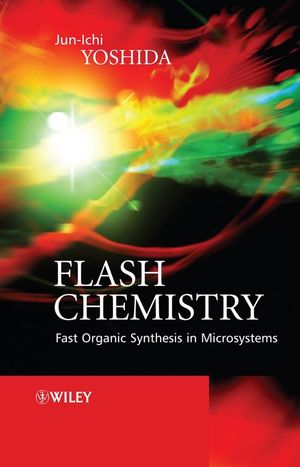Flash Chemistry: Fast Organic Synthesis in MicrosystemsISBN: 978-0-470-03586-3
Hardcover
248 pages
November 2008
 This is a Print-on-Demand title. It will be printed specifically to fill your order. Please allow an additional 10-15 days delivery time. The book is not returnable.
|
||||||
1. Introduction.
1.1 Flask Chemistry.
1.2 Flash Chemistry.
1.3 Flask Chemistry or Flash Chemistry.
2. The Background to Flash Chemistry.
2.1 How do Chemical Reactions Take Place?
3. What is Flash Chemistry?
4. Why is Flash Chemistry Needed?
4.1 Chemical Reaction, an Extremely Fast Process at Molecular Level.
4.2 Rapid Construction of Chemical Libraries.
4.3 Rapid Synthesis of Radioactive Position Emission Tomography Probes.
4.4 On-Demand Rapid Synthesis in Industry.
4.5 Conclusions.
5. Methods of Activating Molecules.
5.1 Thermal Activation of Organic Molecules.
5.2 Photochemical Activation.
5.3 Electrochemical Activation.
5.4 Chemical Activation.
5.5 Accumulation of Reactive Species.
5.6 Continuous Generation of Reactive Species in a Flow System.
5.7 Interconversion Between Reactive Species.
5.8 Conclusions.
6. Control of Extremely Fast Reactions.
6.1 Mixing.
6.2 Temperature Control.
6.3 Residence Time Control.
6.4 Conclusions.
7. Microfluidic Devices and Microflow Systems.
7.1 Brief History.
7.2 Characteristic Features of Microflow Systems.
7.3 Microstructured Fluidic Devices.
7.4 Conclusions.
8. Applications of Flash Chemistry in Organic Synthesis.
8.1 Highly Exothermic Reactions that are Difficult to Control in Macrobatch Reactors.
8.2 Reactions in Which a Reactive Intermediate Easily Decomposes in Macrobatch Reactors.
8.3 Reactions with Products of Which Easily Decompose in Macrobatch Reactors.
8.4 Reactions in Which Undesired By-products are Produced in the Subsequent Reactions In Macrobatch Reactors.
8.5 Reactions That Can Be Accelerated Using Microflow Systems.
8.6 Conclusions.
9. Polymer Synthesis Based on Flash Chemistry.
9.1 Introduction.
9.2 Chain-Growth Polymerization and Step-Growth Polymerization.
9.3 Molecular Weight and Molecular-Weight Distribution.
9.4 Cationic Polymerization.
9.5 Free-Radical Polymerization.
9.6 Conclusions.
10. Industrial Applications of Flash Chemistry.
10.1 Synthesis of Diarylethene as Photochromic Compound (Micrometer-Size Single-Channel Reactor).
10.2 Synthesis of Pharmaceutically Interesting Spiro Lactone Fragment Of Nueropeptide Y (Millimeter-Size Channel-Single Reactor).
10.3 Grignard Exchange Process (Internal numbering-up).
10.4 Radical Polymerization Process (Numbering-up).
10.5 Other examples of Industrial Applications of Flash Chemistry .
10.6 Flash Chemistry as a Powerful Means of Sustainable Chemical Synthesis.
10.7 Conclusions.
11. Outlook of Flash Chemistry.
Index.



